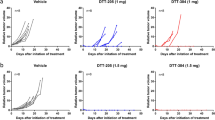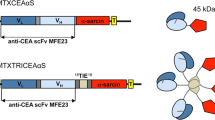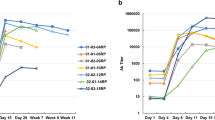Abstract
Immunotoxin LMB–1 is composed of monoclonal antibody B3 chemically linked to PE38, a genetically engineered form of Pseudomonas exotoxin. B3 recognizes a carbohydrate antigen (LeY) present on many human solid tumors1. LMB–1 has excellent antitumor activity in nude mice bearing LeY–positive tumors2. We conducted a phase I study of 38 patients with solid tumors who failed conventional therapy and whose tumors expressed the LeY antigen. Objective antitumor activity was observed in 5 patients, 18 had stable disease, 15 progressed. A complete remission was observed in a patient with metastatic breast cancer to supraclavicular nodes. A greater than 75% tumor reduction and resolution of all clinical symptoms lasting for more than six months was observed in a colon cancer patient with extensive retroperitoneal and cervical metastasis. Three patients (two colon, one breast cancer) had minor responses. The maximum tolerated dose of LMB–1 is 75 μg/kg given intravenously three times every other day. The major toxicity is vascular leak syndrome manifested by hypoalbuminemia, fluid retention, hypotension and, in one case, pulmonary edema. Although immunotoxins have been evaluated in clinical studies for more than two decades, this is the first report of antitumor activity in epithelial tumors.
This is a preview of subscription content, access via your institution
Access options
Subscribe to this journal
Receive 12 print issues and online access
$209.00 per year
only $17.42 per issue
Buy this article
- Purchase on Springer Link
- Instant access to full article PDF
Prices may be subject to local taxes which are calculated during checkout
Similar content being viewed by others
References
Pastan, I. et al. Characterization of monoclonal antibodies Bl and B3 that react with mucinous adenocarcinomas. Cancer Res. 51, 3781–3187 (1991).
Pai, L.H. & Pastan, I. Immunotoxin therapy for cancer. JAMA 269, 78 (1993).
Pai, L.H. & Pastan, I. Monoclonal antibodies in cancer therapy: Immunotoxins and recombinant toxins. in Biologic Therapy of Cancer 2nd edn. (eds DeVita, V.T., Hellman, S. & Rosenberg, S.A.) 521–533 (Lippincott, Philadelphia, 1995).
Vitetta, E.S. et al. Phase I immunotoxin trial in patients with B cell lymphoma. Cancer Res. 51, 4052–4058 (1991).
French, R.R., Hamblin, T.J., Bell, A.J., Tutt, A.L. & Glennie, M. Treatment of B-cell lymphomas with combination of bispecific antibodies and saporin. Lancet 346, 223–224 (1995).
Gould, B.J. et al. Phase I study of an anti-breast cancer immunotoxin by continuous infusion: Report of a target toxic effect not predicted by animal studies. J. Natl. Cancer Inst. 81, 775–781 (1989).
Allured, V.S. et al. Structure of exotoxin A of Pseudomonas aeruginosa at 3.0 Angstrom. Proc. Natl. Acad. Sci. USA 83, 1320–1324 (1986).
Hwang, J., FitzGerald, D.J., Adhya, S. & Pastan, I. Functional domains of Pseudomonas exotoxin identified by deletion analysis of the gene expressed in E. coli. Cell 48, 129–136 (1987).
Kondo, T., FitzGerald, D., Chaudhary, V.K., Adhya, S. & Pastan, I. Activity of immunotoxins constructed with modified Pseudomonas exotoxin A lacking the cell recognitionmain. J. Biol. Chem. 263 9470–9475 (1988).
Pastan, I.H., Pai, L.H., Brinkmann, U. & FitzGerald, D.J. Recombinant toxins: New therapeutic agents for cancer. Ann. N.Y. Acad. Sci. 758, 345–354 (1995).
Kuan, C.-T., Pai, L.H. & Pastan, I. Immunotoxins containing Pseudomonas exotoxin targeting LeY damage human endothelial cells in an antibody specific mode: Relevance to vascular leak syndrome. Clin. Cancer Res. (in the press).
Roscoe, D.M. et al. Primate antibody response to immunotoxins: Serological and computer-aided analysis of epitopes on a truncated form of Pseudomonas exotoxin. Infect. Immun. 62, 5055–5065 (1994).
Wang, Q.-c., Pai, L.H., Debinski, W., FitzGerald, D.J. & Pastan, I. Preparation of polyethylene glycol modified forms of TGFα-PE40 that are cytotoxic and have a markedly prolonged survival in the circulation of mice. Cancer Res. 53 4588–4594 (1993).
Yoshimoto, T. et al. Characterization of polyethylene glycol-modified L-asparaginase from Escherichia coli and its application to therapy of leukemia. Jpn. J. Cancer Res. 77, 1264–1270 (1986).
Jain, R.K. & Baxter, L.T. Mechanisms of heterogeneous distribution of monoclonal antibodies and other macromolecules in tumors: Significance of elevated interstitial pressure. Cancer Res. 48, 7022–7032 (1988).
Brinkmann, U., Pai, L.H., FitzGerald, D.J., Willingham, M.C. & Pastan, I., B3(Fv)-PE38KDEL, a single-chain immunotoxin that causes complete regression of a human carcinoma in mice. Proc. Natl. Acad. Sci. USA 88, 8616–8620 (1991).
Willingham, M. Immunohistochemical methods: Useful and informative tools for screening of hybridomas in the evaluation of antigen expression. Focus 12, 62–67 (1990).
Author information
Authors and Affiliations
Rights and permissions
About this article
Cite this article
Pai, L., Wittes, R., Setser, A. et al. Treatment of advanced solid tumors with immunotoxin LMB–1: An antibody linked to Pseudomonas exotoxin. Nat Med 2, 350–353 (1996). https://doi.org/10.1038/nm0396-350
Received:
Accepted:
Issue Date:
DOI: https://doi.org/10.1038/nm0396-350
This article is cited by
-
Phase I trial of EpCAM-targeting immunotoxin MOC31PE, alone and in combination with cyclosporin
British Journal of Cancer (2015)
-
Purification of clinical-grade disulfide stabilized antibody fragment variable—Pseudomonas exotoxin conjugate (dsFv-PE38) expressed in Escherichia coli
Applied Microbiology and Biotechnology (2013)
-
Treatment of hepatocellular carcinoma in a mouse xenograft model with an immunotoxin which is engineered to eliminate vascular leak syndrome
Cancer Immunology, Immunotherapy (2007)
-
Immunotoxin therapy of cancer
Nature Reviews Cancer (2006)



